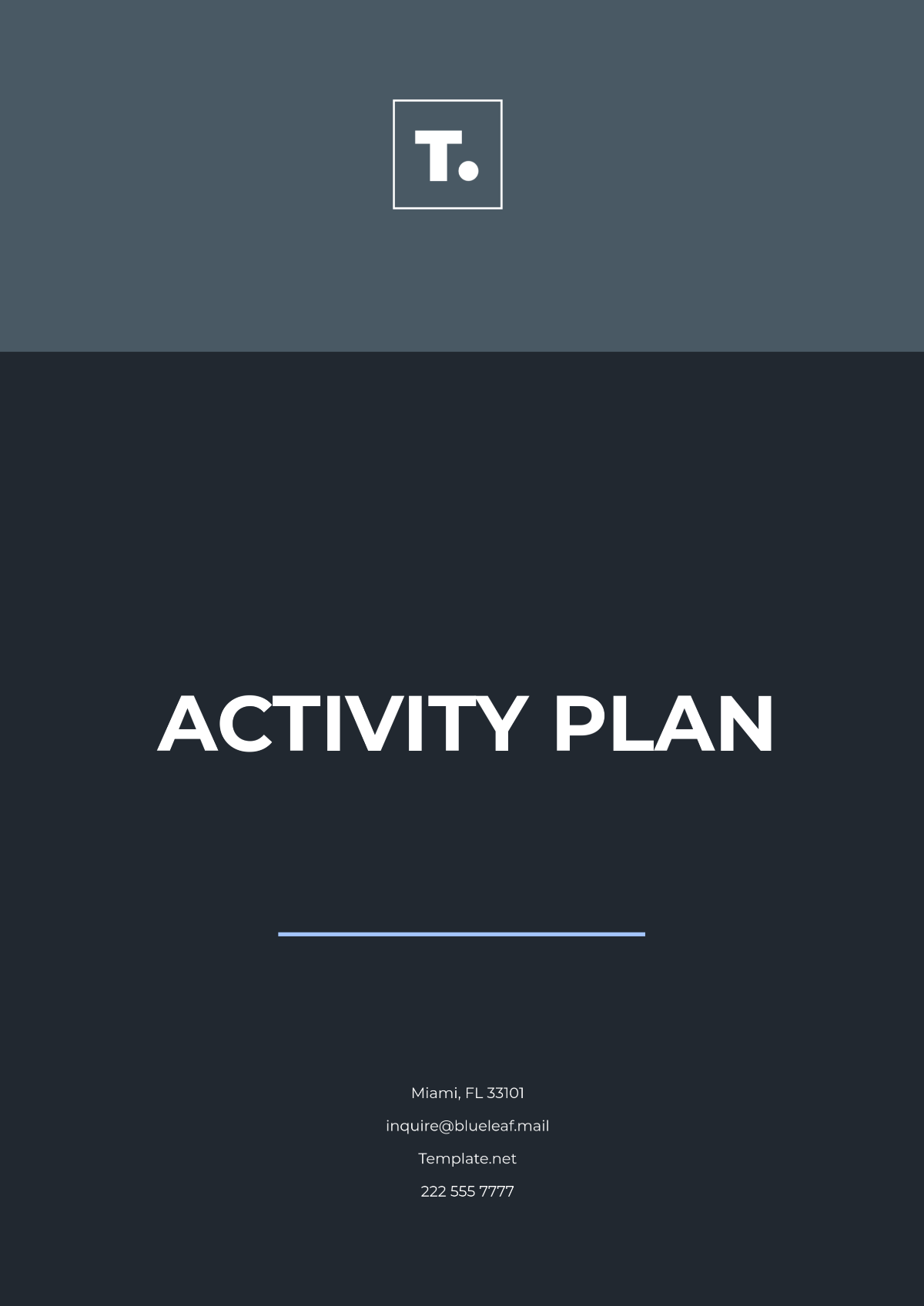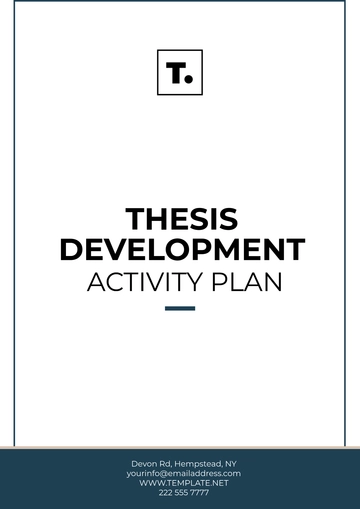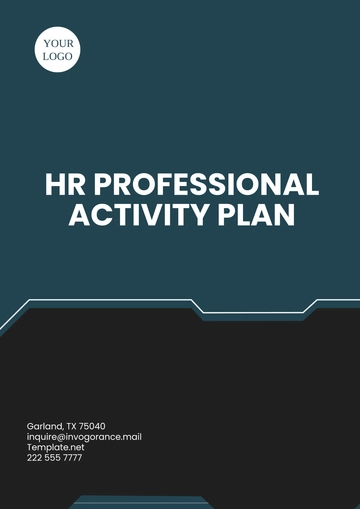Free Activity Plan

1. Introduction
This document provides a detailed, comprehensive plan to establish a structured framework for the seamless organization and execution of activities. The framework is designed to ensure that all critical resources, steps, and timelines are properly accounted for, promoting effective implementation and driving successful outcomes. By following this well-defined approach, the activity will be organized systematically, ensuring optimal performance and efficiency.
2. Objectives
The overarching goal of this plan is to create a methodical approach that streamlines the activity's execution. This includes clearly defined objectives, measurable goals, and tangible deliverables to ensure a high level of organization and accountability throughout the process. By establishing a clear structure, the plan aims to reduce risks, avoid delays, and ensure that each milestone is met in a timely and efficient manner.
3. Resources
3.1 Human Resources
Project Manager
Responsible for overseeing the entire project, ensuring resources are allocated effectively, timelines are adhered to, and team members are supported throughout the execution.
Team Members
Each team member will be assigned specific tasks and responsibilities based on their expertise and role in the project. Their collaboration will be essential for the overall success of the activity.
External Consultants
If needed, external consultants will be brought in to provide specialized expertise or advice on specific aspects of the project, ensuring that all technical or strategic aspects are handled with precision.
3.2 Material Resources
Equipment
All necessary equipment, tools, and infrastructure required for the successful completion of the activity will be identified and secured. This may include physical materials or technology-based tools.
Software Tools
Software tools will be selected to support project management, tracking, and communication needs. These tools will enable the team to monitor progress, document activities, and collaborate effectively.
Documentation
Relevant documentation, such as project briefs, technical specifications, and regulatory guidelines, will be gathered and made readily available to ensure clarity and transparency throughout the process.
3.3 Financial Resources
Budget Allocation
A comprehensive budget will be developed, outlining the financial requirements needed for each phase of the project. This will ensure sufficient funding for all resources, including personnel, materials, and equipment.
Cost Analysis
Detailed analysis will be conducted to predict costs, identify potential financial risks, and explore cost-effective solutions, ensuring that the project remains within budget.
Financial Milestones
Specific financial milestones will be established to track spending and ensure that funds are being utilized appropriately throughout the project lifecycle.
4. Timeline
4.1 Planning Phase
Timeframe: 2 weeks
During this phase, the project plan will be developed, key resources identified, and objectives finalized. A project schedule will also be created to establish deadlines for each phase.
4.2 Implementation Phase
Timeframe: 4 weeks
This phase involves the actual execution of the project. Resources will be deployed, and tasks will be carried out according to the plan, with continuous monitoring to ensure progress aligns with expectations.
4.3 Review and Evaluation Phase
Timeframe: 1 week
At the end of the project, outcomes will be reviewed against initial objectives. Performance metrics will be assessed, and stakeholder feedback will be collected to evaluate the effectiveness of the project and identify areas for improvement.
5. Execution Steps
Identify and Document Objectives
Outline the activity's goals, deliverables, and KPIs for a shared understanding of purpose and success.Assemble the Team and Assign Roles
Form a skilled team, assigning roles based on expertise for clear task delegation and accountability.Gather and Secure Resources
Secure and distribute essential resources to ensure readiness for success.Develop a Detailed Project Schedule
Develop a detailed project timeline with milestones and deadlines to keep activities on track.Implement the Plan According to the Timeline
Start the plan as scheduled and provide regular updates to keep the team aligned.Monitor Progress and Make Adjustments as Necessary
Continuous monitoring enables real-time adjustments, promptly addressing unforeseen challenges.Review Outcomes and Evaluate Effectiveness
After completing the activity, evaluate the results with KPIs and collect stakeholder feedback to gauge success and find improvement areas.
6. Evaluation and Feedback
Following the implementation, feedback will be gathered from all stakeholders, including team members, external consultants, and relevant parties. This feedback will be used to assess the overall success of the activity and to provide insights for future projects. A comprehensive evaluation report will be compiled, detailing the activity's strengths, areas for improvement, and lessons learned to enhance future planning and execution processes.
7. Conclusion
This structured framework provides a detailed roadmap for organizing and executing the activity, ensuring that all necessary resources, steps, and timelines are carefully considered. By following this plan, the activity will be executed efficiently and effectively, leading to successful outcomes and providing a valuable foundation for future projects. This approach will promote clarity, accountability, and a smooth flow of tasks, ensuring that the project meets its objectives within the established timeframe and budget.
- 100% Customizable, free editor
- Access 1 Million+ Templates, photo’s & graphics
- Download or share as a template
- Click and replace photos, graphics, text, backgrounds
- Resize, crop, AI write & more
- Access advanced editor
Plan your activities effectively with the Activity Plan Template offered by Template.net. This customizable, downloadable, and printable template is designed to suit various needs, from personal projects to professional schedules. Easily editable in our AI Editor Tool, it ensures a seamless experience for tailoring your plan to perfection. Achieve organization and productivity effortlessly!
You may also like
- Finance Plan
- Construction Plan
- Sales Plan
- Development Plan
- Career Plan
- Budget Plan
- HR Plan
- Education Plan
- Transition Plan
- Work Plan
- Training Plan
- Communication Plan
- Operation Plan
- Health And Safety Plan
- Strategy Plan
- Professional Development Plan
- Advertising Plan
- Risk Management Plan
- Restaurant Plan
- School Plan
- Nursing Home Patient Care Plan
- Nursing Care Plan
- Plan Event
- Startup Plan
- Social Media Plan
- Staffing Plan
- Annual Plan
- Content Plan
- Payment Plan
- Implementation Plan
- Hotel Plan
- Workout Plan
- Accounting Plan
- Campaign Plan
- Essay Plan
- 30 60 90 Day Plan
- Research Plan
- Recruitment Plan
- 90 Day Plan
- Quarterly Plan
- Emergency Plan
- 5 Year Plan
- Gym Plan
- Personal Plan
- IT and Software Plan
- Treatment Plan
- Real Estate Plan
- Law Firm Plan
- Healthcare Plan
- Improvement Plan
- Media Plan
- 5 Year Business Plan
- Learning Plan
- Marketing Campaign Plan
- Travel Agency Plan
- Cleaning Services Plan
- Interior Design Plan
- Performance Plan
- PR Plan
- Birth Plan
- Life Plan
- SEO Plan
- Disaster Recovery Plan
- Continuity Plan
- Launch Plan
- Legal Plan
- Behavior Plan
- Performance Improvement Plan
- Salon Plan
- Security Plan
- Security Management Plan
- Employee Development Plan
- Quality Plan
- Service Improvement Plan
- Growth Plan
- Incident Response Plan
- Basketball Plan
- Emergency Action Plan
- Product Launch Plan
- Spa Plan
- Employee Training Plan
- Data Analysis Plan
- Employee Action Plan
- Territory Plan
- Audit Plan
- Classroom Plan
- Activity Plan
- Parenting Plan
- Care Plan
- Project Execution Plan
- Exercise Plan
- Internship Plan
- Software Development Plan
- Continuous Improvement Plan
- Leave Plan
- 90 Day Sales Plan
- Advertising Agency Plan
- Employee Transition Plan
- Smart Action Plan
- Workplace Safety Plan
- Behavior Change Plan
- Contingency Plan
- Continuity of Operations Plan
- Health Plan
- Quality Control Plan
- Self Plan
- Sports Development Plan
- Change Management Plan
- Ecommerce Plan
- Personal Financial Plan
- Process Improvement Plan
- 30-60-90 Day Sales Plan
- Crisis Management Plan
- Engagement Plan
- Execution Plan
- Pandemic Plan
- Quality Assurance Plan
- Service Continuity Plan
- Agile Project Plan
- Fundraising Plan
- Job Transition Plan
- Asset Maintenance Plan
- Maintenance Plan
- Software Test Plan
- Staff Training and Development Plan
- 3 Year Plan
- Brand Activation Plan
- Release Plan
- Resource Plan
- Risk Mitigation Plan
- Teacher Plan
- 30 60 90 Day Plan for New Manager
- Food Safety Plan
- Food Truck Plan
- Hiring Plan
- Quality Management Plan
- Wellness Plan
- Behavior Intervention Plan
- Bonus Plan
- Investment Plan
- Maternity Leave Plan
- Pandemic Response Plan
- Succession Planning
- Coaching Plan
- Configuration Management Plan
- Remote Work Plan
- Self Care Plan
- Teaching Plan
- 100-Day Plan
- HACCP Plan
- Student Plan
- Sustainability Plan
- 30 60 90 Day Plan for Interview
- Access Plan
- Site Specific Safety Plan





























